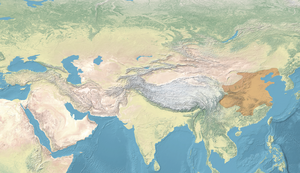| Geographical range | Gansu |
|---|---|
| Dates | 3rd century BCE |
| Major sites | 36°15′41″N 105°04′44″E / 36.2615°N 105.079°E |
| Preceded by | Shajing culture (800–200 BCE)[1] |
| Followed by | Han dynasty |

Majiayuan (Ch:马家垸遗址) is an 3rd-2nd century BCE archaeological site in Gansu, China. The site is considered as belonging to rulers of the culture of the Xirong ("Western Barbarians"), recently subjugated by the state of Qin, who included them within the defensive wall of King Zhao of Qin, built in 271 BCE.[3][4] It is rather similar to another Xirong site about 50 km away, the Wangjiawa cemetery (王家洼墓地).[5] Majiayuan was a zone of interraction between the Chinese and their nomadic neighbours to the west and north during the Warring States period (476–221 BCE).[4]
- ^ Li, Xin; Wei, Wenyu; Ma, Minmin; Lu, Minxia; Du, Linyao; Yang, Yishi; Chen, Guoke; Ren, Lele (2023). "Transformation of animal utilization strategies from the late Neolithic to the Han Dynasty in the Hexi Corridor, northwest China: Zooarchaeological and stable isotopic evidence". Frontiers in Earth Science. 10. doi:10.3389/feart.2022.1064803. ISSN 2296-6463.
- ^ Liu, Yan; Li, Rui; Yang, Junchang; Liu, Ruiliang; Zhao, Guoxing; Tan, Panpan (26 April 2021). "China and the steppe: technological study of precious metalwork from Xigoupan Tomb 2 (4th–3rd c.BCE) in the Ordos region, Inner Mongolia". Heritage Science. 9 (1): 46. doi:10.1186/s40494-021-00520-5. ISSN 2050-7445.
- ^ Cite error: The named reference
Duanwas invoked but never defined (see the help page). - ^ a b Wu, Xiaolong (2013). "Cultural hybridity and social status: elite tombs on China's Northern Frontier during the third century BC". Antiquity. 87 (335): 121. ISSN 0003-598X.
Recent archaeological discoveries from this area, including the Majiayuan cemetery, have revealed more nuanced pictures of cultural exchange between the Chinese states and the pastoral groups to their north and west during the Warring States Period (476–221 BC). (...) The Majiayuan cemetery, however, is fundamentally different from other Qin cemeteries in terms of burial practice and grave goods, and probably represents the remains of the rulers of a Rong pastoralist group newly subjugated by the state of Qin.
- ^ "Aristocratic Cemetery of the Western Rong People at Wangjiawa (Qin'an, Gansu)". The Institute of Archaeology, Chinese Academy of Social Sciences (IA CASS).
© MMXXIII Rich X Search. We shall prevail. All rights reserved. Rich X Search


